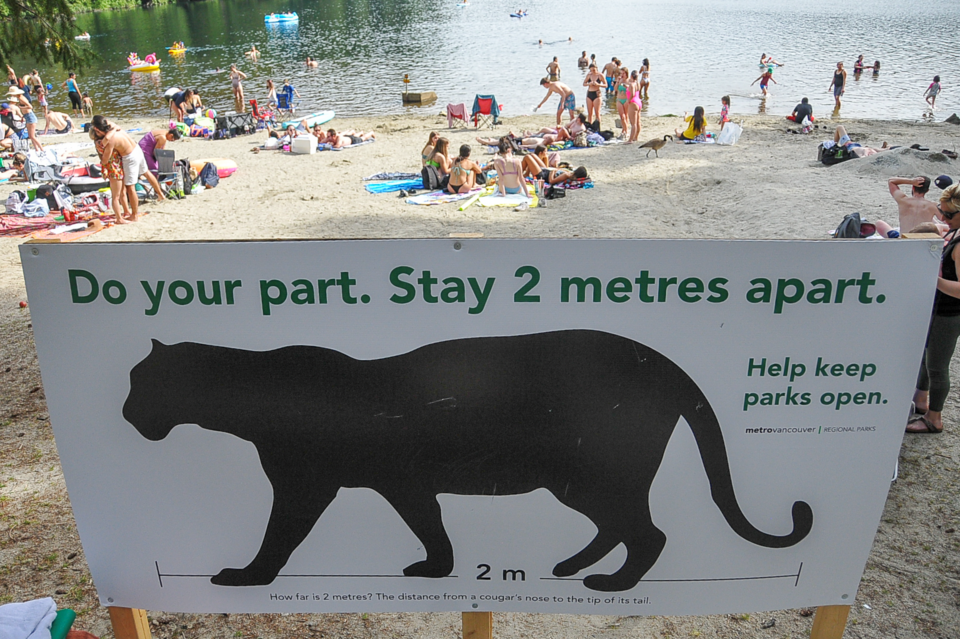For the last few months, the novel coronavirus has inspired what have become useful though worn cliches in the name of public health, from “flatten the curve” to “together, apart.”
In one of the most ubiquitous messages, signs across the world have implored people to stay two-metres — or six feet — apart.
In the Tri-Cities, it has been a key part of School District 43’s decision to not recommend masks for students, and the cities of Port Coquitlam, Port Moody and Coquitlam recently highlighted the social distancing rule-of-thumb for families as playgrounds re-open.
But as we learn more about the behaviour of the novel coronavirus, some experts are warning that message might not be as accurate as we once thought.
In a sourced commentary in the publication Science, three university researchers from the United States and Taiwan — an atmospheric chemist, researcher in infectious disease and public health and a chemist specializing in aerosols — say that unlike some respiratory viruses, which spread through droplets, a growing body of evidence has found that much of the spread of COVID-19 “appears to be occurring through airborne transmission of aerosols produced by asymptomatic individuals during breathing and speaking.”
Virus-laden respiratory droplets, the width of one or two strands of spider silk, often settle to the ground faster than they evaporate, note the authors. That’s where that two-metre rule-of-thumb comes from.
So while the World Health Organization (WHO) recommends keeping a two-metre distance from others and washing your hands frequently to reduce the spread of the coronavirus, those measures “are based on studies of respiratory droplets carried out in the 1930s” when “technology did not exist for detecting submicron aerosols,” according to the authors.
“Measurements now show that intense coughs and sneezes that propel larger droplets more than 20 ft. (six metres) can also create thousands of aerosols that can travel even further.”
That range of transmission is made even more complicated by its asymptomatic spread.
Spreading three-times faster than the virus that causes SARS, the authors say that the novel coronavirus can quickly spread from the lungs up the throat and start shedding, so that by the time symptoms occur, the patient has transmitted the virus without knowing.
These “silent shedders” can be highly contagious for several days and “could be critical drivers of the enhanced spread” of the virus, write the authors. In Wuhan, for example, another study found 79% of undiagnosed cases of COVID-19 were spread by asymptomatic carriers.
Another study carried out in two Wuhan hospitals found the virus present in aerosols further than two metres from patients and in high concentrations in crowded areas.
How a droplet and aerosols travel through the air depends on a range of factors, including its size, inertia, gravity and evaporation.
Indoors, the studies show there is a growing body of evidence that two metres is not enough. Outdoors, fewer studies are available, and while breezes can pick up and transport infectious droplets over long distances, they’re also diluted more quickly and can be inactivated by the ultraviolet light from the sun.
All of that is to say that coming up with a safe distance from a person shedding the coronavirus is difficult. Duration, ventilation and the number of “silent shedders” in an indoor space will all affect how the virus is or is not transmitted.
“For society to resume, measures designed to reduce aerosol transmission must be implemented, including universal masking and regular, widespread testing to identify and isolate infected asymptomatic individuals,” recommended the group of scientists.
Some of the most important places to wear masks are where high concentrations of the virus can accumulate, such as airplanes, restaurants, health care settings and other crowded spaces, they wrote.
It’s not the first time the effectiveness of two-meter social distancing has been questioned. In March, a Massachusetts Institute of Technology study suggested viral droplets from a cough or sneeze could create a gas cloud with a payload of pathogen-bearing droplets extending seven- to eight metres away.
And earlier this month, another study published in the scientific journal Physics of Fluids found that while droplets didn’t travel out of the two-metre social distancing recommendation in windless conditions, wind speeds between four and 15 km/h enabled droplets to travel six metres away.
However, like much of the science around COVID-19, “Our understanding of the mechanisms of airborne transmission of viruses is incomplete,” note the authors, and “further research is required.”



